Japanese Honorifics Guide: Master Respect in Japanese

Written by
Ernest Bio Bogore

Reviewed by
Ibrahim Litinine

Japanese honorifics represent one of the most critical yet misunderstood aspects of language acquisition for non-native speakers. The failure to grasp these linguistic markers doesn't just result in awkward conversations—it fundamentally undermines your ability to navigate Japanese social and professional environments effectively.
The stakes are higher than most learners realize. According to Japan's Ministry of Foreign Affairs, over 3.8 million foreigners currently reside in Japan, with business professionals comprising the largest demographic. Yet cultural miscommunication remains the primary barrier to professional advancement, with honorific misuse ranking as the most frequent linguistic error reported in corporate settings.
This guide dissects the honorific system through a practical lens, focusing on patterns and applications that directly impact your communicative competence. Rather than overwhelming you with exhaustive lists, we'll examine the underlying logic that governs honorific usage and provide frameworks for making correct choices in real-world scenarios.
The Strategic Importance of Japanese Honorifics
Japanese honorifics function as social positioning tools that communicate respect, hierarchy, and relationship dynamics simultaneously. Unlike Western courtesy titles that primarily denote gender or marital status, Japanese honorifics encode complex social information that native speakers process instantaneously.
Consider this critical insight: Japanese business culture operates on a hierarchy-first communication model where acknowledging relative status precedes information exchange. This means your honorific choices signal your understanding of social positioning before you even begin substantive conversation.
The linguistic evidence supports this reality. Japanese honorifics are suffixes—they attach to names and appear in every interpersonal exchange. Their frequency of use makes accuracy non-negotiable for anyone serious about Japanese proficiency.
Core Honorific Categories: The Foundation System
さん (San): The Universal Default
San represents the safest honorific choice across virtually all contexts. Its versatility stems from its neutral positioning—it conveys respect without implying specific relationship dynamics or status differentials.
The strategic value of san lies in its error-resistant nature. Using san when a more specific honorific might be appropriate rarely causes offense, while choosing incorrectly from other options can create immediate social friction.
Practical application extends beyond personal names. Japanese speakers attach san to business names, store references, and even certain foods, reflecting the honorific's role in expressing general respect rather than formal hierarchy.
くん (Kun): Male-Oriented Casual Respect
Kun functions primarily within same-level or downward hierarchical relationships, typically applied to younger males or male peers in informal professional settings. The honorific carries implications of familiarity and approachability that make it inappropriate for formal business interactions.
The gender association isn't absolute—some contexts see kun applied to females, particularly in academic or professional mentorship relationships. However, the default assumption remains male-oriented usage.
Critical consideration: Kun implies the speaker holds equal or superior social position relative to the recipient. Using kun incorrectly suggests relationship dynamics that may not exist, potentially causing significant social awkwardness.
ちゃん (Chan): Affection and Intimacy
Chan signals personal closeness and affection, making it the most emotionally loaded common honorific. Its primary applications involve children, close friends, family members, and romantic relationships.
The intimacy factor creates high stakes for usage. Applying chan inappropriately suggests personal relationships that don't exist, while overusing it can appear childish or disrespectful in professional contexts.
Regional variations add complexity—Osaka speakers commonly attach chan to food items and everyday objects, reflecting local linguistic patterns that visitors must recognize to avoid confusion.
様 (Sama): Formal Respect and Business Protocol
Sama represents the highest level of honorific respect in standard usage, reserved for formal business relationships, customer service interactions, and situations requiring maximum politeness.
The customer service industry universally employs sama when addressing clients, reflecting its role in communicating deference and professional respect. This usage pattern provides clear guidance for learners—when business transactions or formal services are involved, sama becomes the default choice.
Understanding sama's weight prevents overuse, which can appear sarcastic or excessively formal in casual contexts.
先生 (Sensei): Professional Authority Recognition
Sensei acknowledges professional expertise and authority, extending beyond teachers to include doctors, lawyers, politicians, and skilled craftspeople. Unlike other honorifics, sensei can function independently without a personal name.
The standalone usage reflects sensei's role in recognizing expertise rather than simply showing respect. This functional difference makes sensei unique among common honorifics and explains its persistence in professional vocabularies worldwide.
Context-Driven Decision Making: The Practical Framework
Successful honorific usage requires rapid context assessment across multiple variables simultaneously. The decision-making process involves evaluating relationship dynamics, social settings, and communication objectives within seconds of interaction.
Relationship Hierarchy Assessment
Japanese social interaction operates on clearly defined hierarchical principles that determine honorific choices. Age, professional status, social position, and situational context all contribute to this calculation.
The business environment provides the clearest examples. Junior employees addressing senior colleagues invariably use san or sama, while seniors may use kun or san when addressing juniors, depending on the formality level required by the situation.
Educational settings demonstrate similar patterns, with students using san or sensei for instructors, while teachers may use kun or chan for students based on age and relationship development.
Situational Formality Calibration
Context formality overrides relationship familiarity in many scenarios. Close colleagues who typically use kun or chan in casual settings switch to san during formal meetings, client presentations, or official business communications.
This calibration ability separates competent speakers from those who apply honorifics mechanically. The skill requires understanding that situational demands can temporarily alter standard relationship-based choices.
Professional Environment Navigation
Business contexts in Japan operate under strict honorific protocols that foreign professionals must master for career advancement. Client interactions default to sama usage, internal communications typically employ san, and presentation settings may require elevated formality regardless of personal relationships.
The consequences of honorific errors in professional settings extend beyond momentary embarrassment. Incorrect usage can signal cultural incompetence that affects career prospects, client relationships, and team integration.
Real-World Application Examples
Corporate Meeting Scenarios
When addressing your direct supervisor in a team meeting, san provides appropriate respect without excessive formality: "田中さん、この件についていかがお考えですか?" (Tanaka-san, kono ken ni tsuite ikaga okangae desu ka? - Mr./Ms. Tanaka, what are your thoughts on this matter?)
Client presentations require sama elevation: "山田様のご意見をお聞かせください" (Yamada-sama no go-iken wo okikase kudasai - Please share your opinion, Mr./Ms. Yamada).
Educational Interactions
Student-teacher dynamics clearly demonstrate sensei usage: "田中先生、質問があります" (Tanaka-sensei, shitsumon ga arimasu - Professor Tanaka, I have a question).
The sensei designation acknowledges professional authority while maintaining appropriate student-educator boundaries.
Social Setting Applications
Casual interactions among peers typically employ kun for males: "佐藤君、週末の予定はどう?" (Sato-kun, shūmatsu no yotei wa dō? - Sato, how are your weekend plans?)
Close friendships, particularly involving females, may utilize chan: "美穂ちゃん、元気?" (Miho-chan, genki? - Miho, how are you doing?)
Advanced Concept: Honorific Nouns and Objects
Japanese honorific principles extend beyond personal address to encompass objects, concepts, and activities deemed worthy of respectful treatment. This extension reveals the depth of honorific thinking in Japanese culture.
The お (O) and ご (Go) Prefix System
Honorific prefixes transform ordinary nouns into respectful expressions. The choice between お and ご follows phonetic and etymological patterns that native speakers internalize but foreign learners must study systematically.
お typically attaches to native Japanese words (和語, wago):
- お米 (okome) - rice
- お酒 (osake) - alcohol
- お茶 (ocha) - tea
- お箸 (ohashi) - chopsticks
ご generally prefixes Chinese-origin words (漢語, kango):
- ご注文 (gochūmon) - order
- ご飯 (gohan) - meal
- ご質問 (goshitsumon) - question
Cultural Significance of Object Honorifics
The selection of items receiving honorific treatment reflects Japanese cultural values. Rice, tea, and chopsticks earn respectful designation due to their fundamental roles in Japanese daily life and cultural identity.
Business-related terms like 注文 (order) and 質問 (question) receive ご prefixes in professional contexts, emphasizing the respectful nature of commercial and educational interactions.
This systematic elevation of everyday objects through linguistic respect demonstrates how deeply honorific thinking permeates Japanese communication patterns.
Keigo: The Advanced Honorific System
Keigo represents the most sophisticated level of Japanese honorific expression, dividing into distinct categories that serve specific communicative functions. Mastering keigo separates competent speakers from those who merely understand basic honorific suffixes.
尊敬語 (Sonkeigo): Elevating Others
Sonkeigo elevates the actions and states of others, demonstrating respect by linguistically honoring their activities. This form requires speakers to select entirely different vocabulary when describing what others do.
Standard Japanese uses 言います (iimasu) for "say," but sonkeigo transforms this to おっしゃいます (osshaimasu) when describing another person's speech. The vocabulary change signals respect through linguistic elevation.
Additional sonkeigo transformations include:
- する (suru) → なさる (nasaru) - to do
- 見る (miru) → ご覧になる (goran ni naru) - to see
- 来る (kuru) → いらっしゃる (irassharu) - to come
謙譲語 (Kenjōgo): Humbling Yourself
Kenjōgo operates in reverse, using humble vocabulary when describing your own actions to elevate others by comparison. This form demonstrates respect through self-diminishment rather than other-elevation.
The same "say" concept becomes 申します (mōshimasu) in kenjōgo, acknowledging your speech as less significant than your listener's potential response.
Key kenjōgo patterns:
- する (suru) → いたします (itashimasu) - to do (humbly)
- あげる (ageru) → 差し上げる (sashiageru) - to give (humbly)
- 行く (iku) → 参ります (mairimasu) - to go (humbly)
Strategic Keigo Application
Keigo usage in business contexts follows predictable patterns that learners can master through systematic practice. Customer service interactions universally employ sonkeigo when describing customer actions and kenjōgo when describing company responses.
Internal corporate communications may utilize modified keigo levels depending on hierarchical relationships and situational formality. The ability to adjust keigo intensity based on context requirements demonstrates advanced cultural competence.
Common Pitfalls and Strategic Avoidance
Overformality Errors
Beginning learners often overuse formal honorifics, creating social distance where familiarity would be more appropriate. Using sama consistently in casual settings appears rigid and prevents natural relationship development.
The correction requires understanding that honorifics facilitate social connection rather than create barriers. Appropriate honorific reduction signals growing familiarity and relationship comfort.
Underformality Mistakes
Conversely, dropping honorifics too quickly or using casual forms in formal contexts signals cultural insensitivity. Business relationships require sustained san usage regardless of personal comfort levels.
Professional environments demand consistent honorific maintenance throughout working relationships. Personal friendships may develop separately from professional interactions, but workplace honorific protocols remain non-negotiable.
Gender Assumption Problems
Assuming kun exclusively applies to males or chan only to females creates usage errors that native speakers immediately notice. Context and relationship dynamics determine appropriate choices more than gender considerations alone.
The solution involves focusing on relationship characteristics rather than demographic assumptions when selecting honorifics.
Cultural Context: Why Honorifics Matter Beyond Language
Japanese honorific usage reflects fundamental cultural values that influence business practices, social interactions, and relationship development patterns. Understanding these underlying principles provides insight into Japanese behavioral expectations beyond mere linguistic accuracy.
Hierarchical Communication Patterns
Japanese society operates on clearly defined hierarchical principles that honorifics both reflect and reinforce. These patterns influence decision-making processes, information flow, and authority recognition in ways that affect practical outcomes.
Business meetings demonstrate these patterns through speaking order, honorific usage, and deference displays that communicate organizational structure without explicit statements. Foreign professionals who recognize and adapt to these patterns integrate more successfully into Japanese work environments.
Respect as Social Currency
Honorific usage functions as a form of social currency that speakers invest in relationship building and maintenance. Consistent appropriate usage builds trust and demonstrates cultural understanding that facilitates business relationships and personal connections.
The investment metaphor proves particularly relevant in business contexts where long-term relationships determine success more than individual transaction outcomes. Honorific competence signals reliability and cultural sensitivity that Japanese partners value highly.
Technology and Modern Honorific Evolution
Digital communication platforms have introduced new considerations for honorific usage that traditional textbooks don't address. Email, messaging apps, and social media create contexts where honorific rules require adaptation rather than direct application.
Digital Communication Adaptations
Business emails maintain formal honorific structures, but brevity requirements sometimes conflict with traditional politeness patterns. Modern Japanese speakers develop strategies for maintaining respect while accommodating technological constraints.
Social media interactions blend formality levels in ways that create new honorific usage patterns. Understanding these evolving conventions requires exposure to contemporary Japanese digital communication rather than relying solely on traditional sources.
Generational Differences
Younger Japanese speakers sometimes modify traditional honorific patterns in casual digital contexts while maintaining strict formality in face-to-face professional interactions. These generational variations affect how foreign speakers should adapt their honorific usage based on audience demographics.
Practical Mastery Strategies
Pattern Recognition Development
Successful honorific usage depends on pattern recognition rather than memorizing individual rules. Observing native speaker interactions across various contexts reveals consistent patterns that learners can internalize and apply systematically.
Business environment observation provides particularly valuable learning opportunities since professional contexts follow predictable honorific protocols. Regular exposure to these patterns builds intuitive understanding that surpasses rule-based learning approaches.
Error Recovery Techniques
Honorific mistakes are inevitable during the learning process, but recovery strategies can minimize their impact. Acknowledging errors briefly and moving forward often proves more effective than lengthy apologies that draw additional attention to mistakes.
Native speakers generally appreciate honorific attempts from foreign speakers and rarely react negatively to minor errors when overall communication intent remains clear.
Progressive Complexity Building
Beginning with san as a universal default provides a foundation for gradually introducing more specific honorifics as contextual understanding develops. This progressive approach prevents overwhelming complexity while building confidence through consistent appropriate usage.
Advanced learners can begin incorporating keigo elements once basic honorific patterns become automatic, following the same gradual progression that allows sustainable skill development.
Learn Any Language with Kylian AI
Private language lessons are expensive. Paying between 15 and 50 euros per lesson isn’t realistic for most people—especially when dozens of sessions are needed to see real progress.
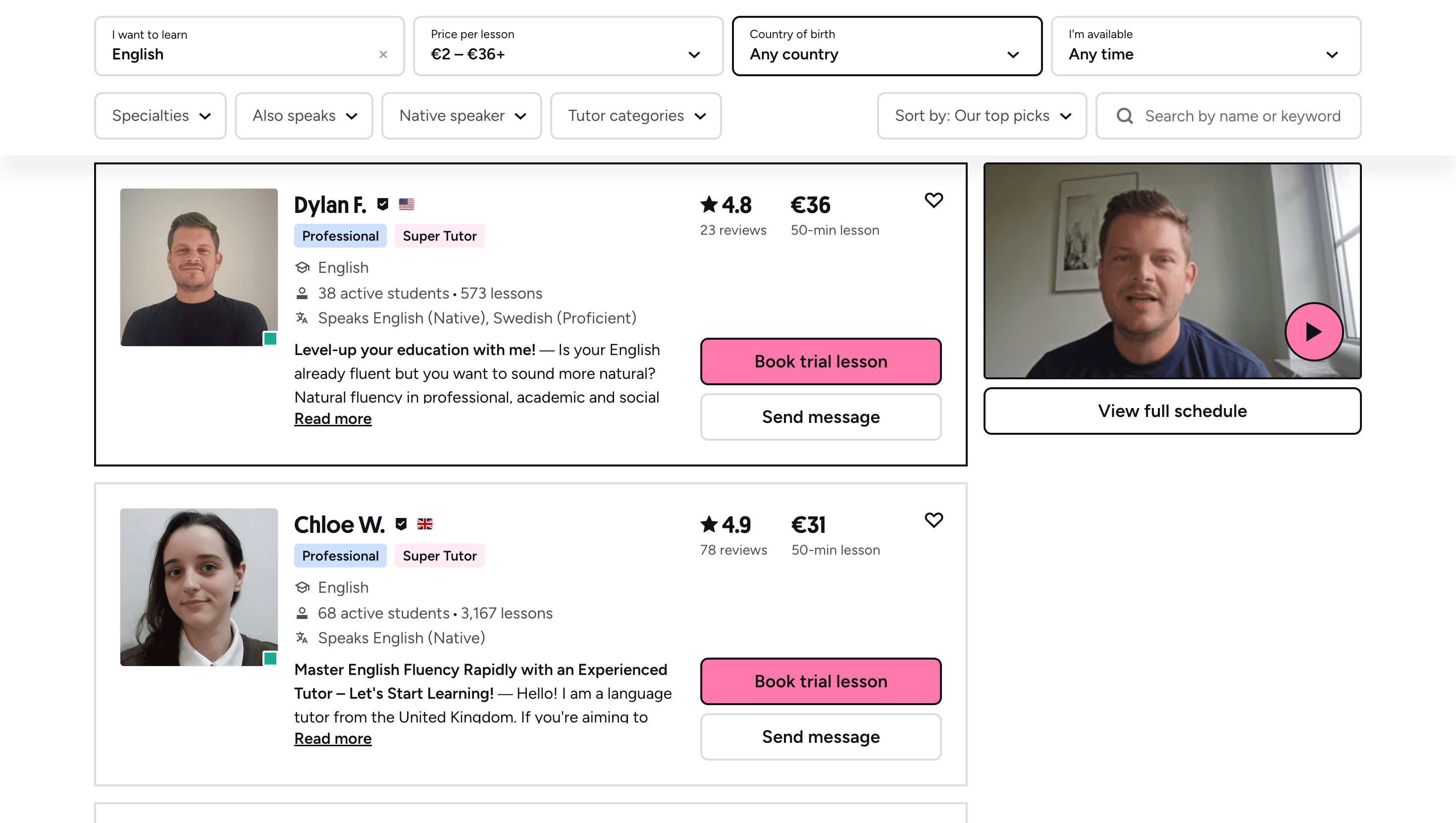
Many learners give up on language learning due to these high costs, missing out on valuable professional and personal opportunities.
That’s why we created Kylian: to make language learning accessible to everyone and help people master a foreign language without breaking the bank.
To get started, just tell Kylian which language you want to learn and what your native language is
Tired of teachers who don’t understand your specific struggles as a French speaker? Kylian’s advantage lies in its ability to teach any language using your native tongue as the foundation.
Unlike generic apps that offer the same content to everyone, Kylian explains concepts in your native language (French) and switches to the target language when necessary—perfectly adapting to your level and needs.
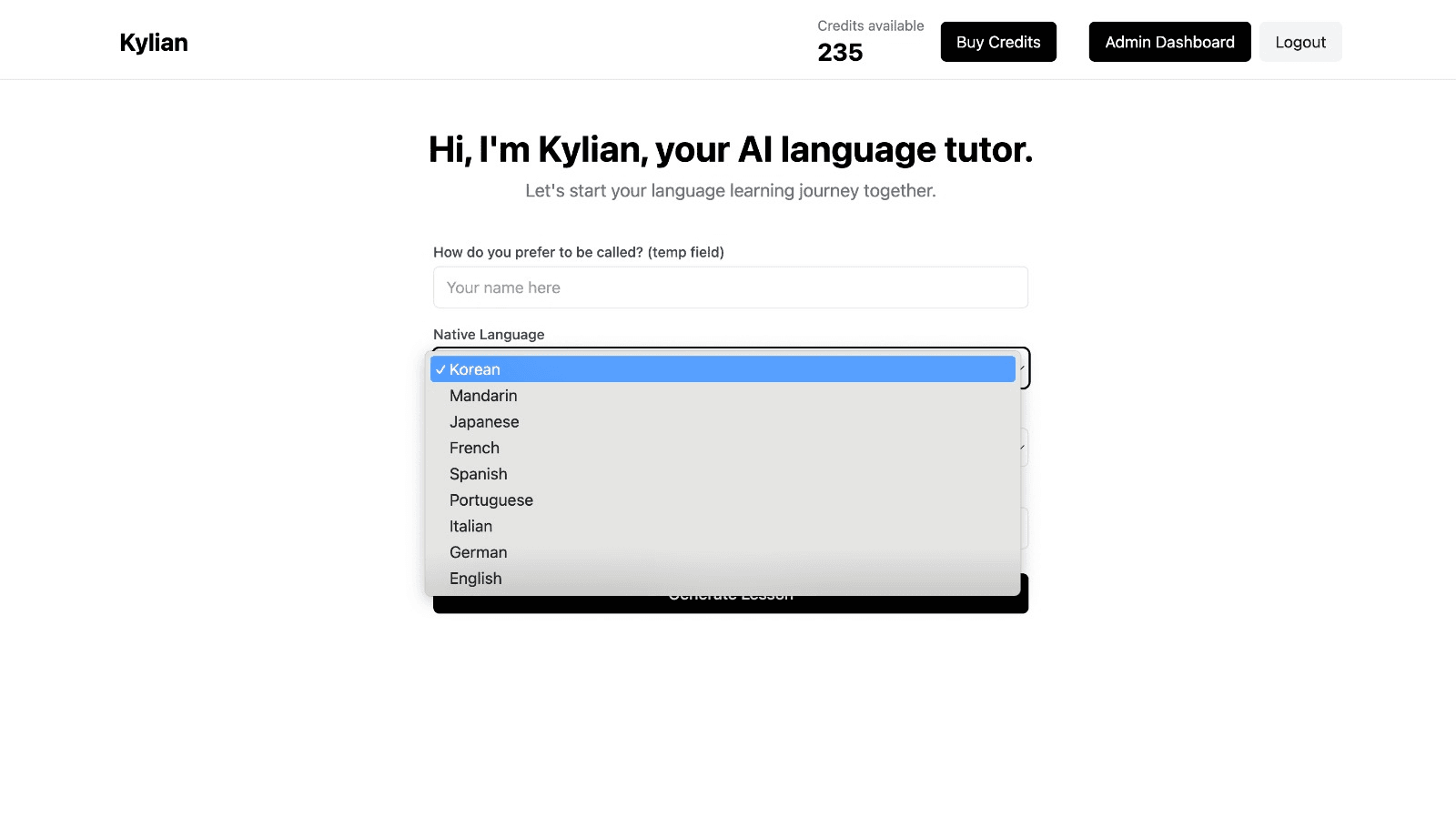
This personalization removes the frustration and confusion that are so common in traditional language learning.
Choose a specific topic you want to learn
Frustrated by language lessons that never cover exactly what you need? Kylian can teach you any aspect of a language—from pronunciation to advanced grammar—by focusing on your specific goals.
Avoid vague requests like “How can I improve my accent?” and be precise: “How do I pronounce the R like a native English speaker?” or “How do I conjugate the verb ‘to be’ in the present tense?”
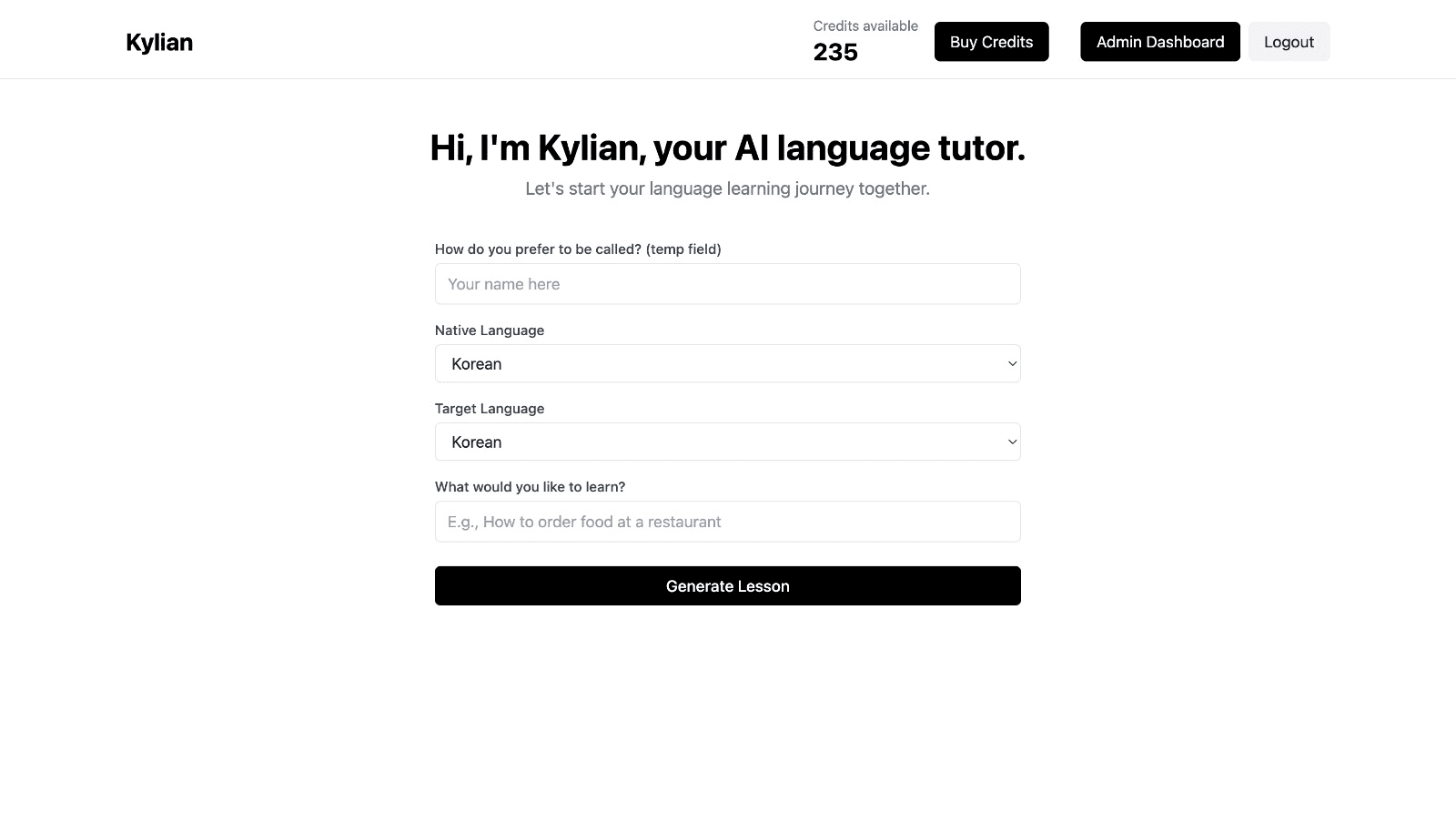
With Kylian, you’ll never again pay for irrelevant content or feel embarrassed asking “too basic” questions to a teacher. Your learning plan is entirely personalized.
Once you’ve chosen your topic, just hit the “Generate a Lesson” button, and within seconds, you’ll get a lesson designed exclusively for you.
Join the room to begin your lesson
The session feels like a one-on-one language class with a human tutor—but without the high price or time constraints.
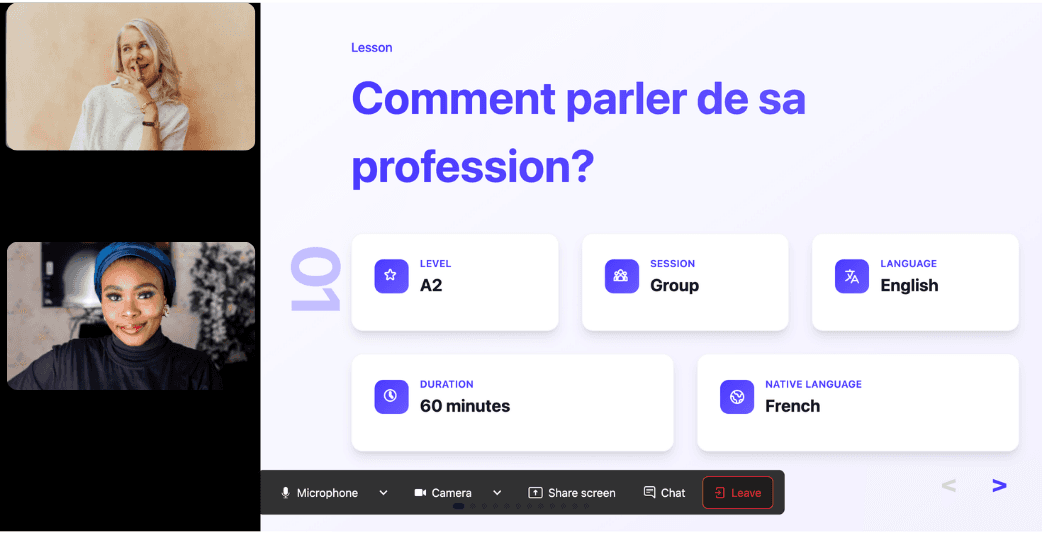
In a 25-minute lesson, Kylian teaches exactly what you need to know about your chosen topic: the nuances that textbooks never explain, key cultural differences between French and your target language, grammar rules, and much more.
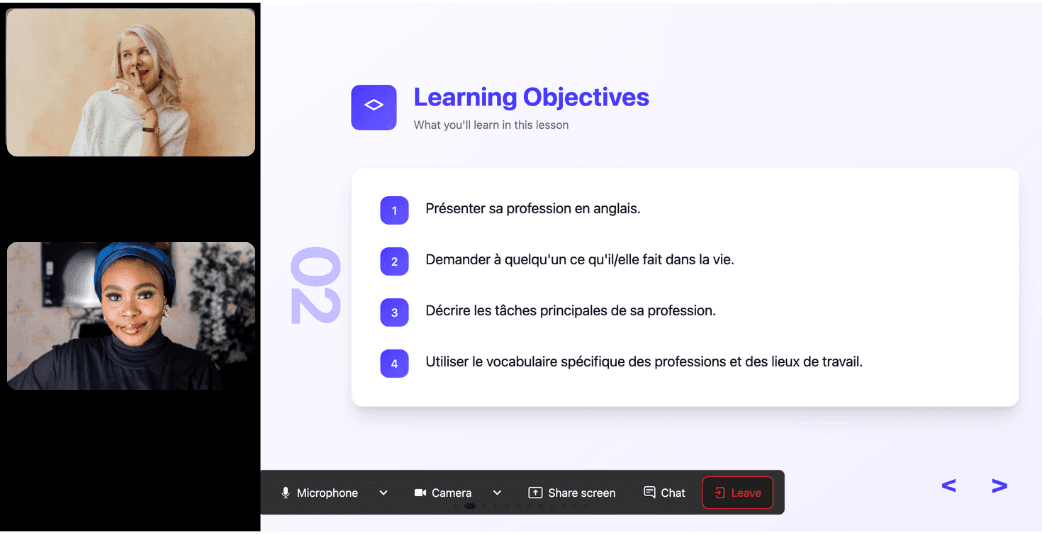
Ever felt frustrated trying to keep up with a native-speaking teacher, or embarrassed to ask for something to be repeated? With Kylian, that problem disappears. It switches intelligently between French and the target language depending on your level, helping you understand every concept at your own pace.
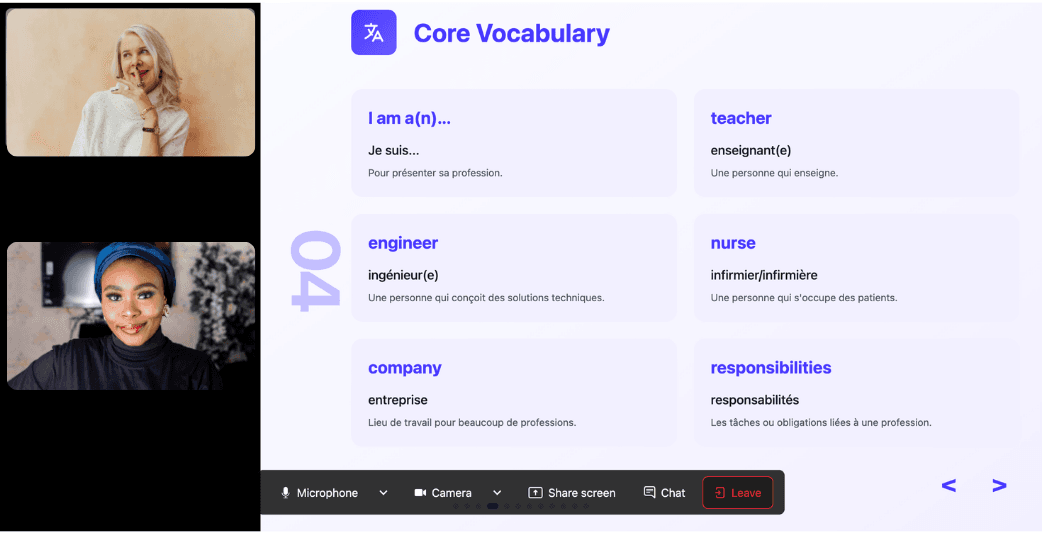
During the lesson, Kylian uses role-plays, real-life examples, and adapts to your learning style. Didn’t understand something? No problem—you can pause Kylian anytime to ask for clarification, without fear of being judged.
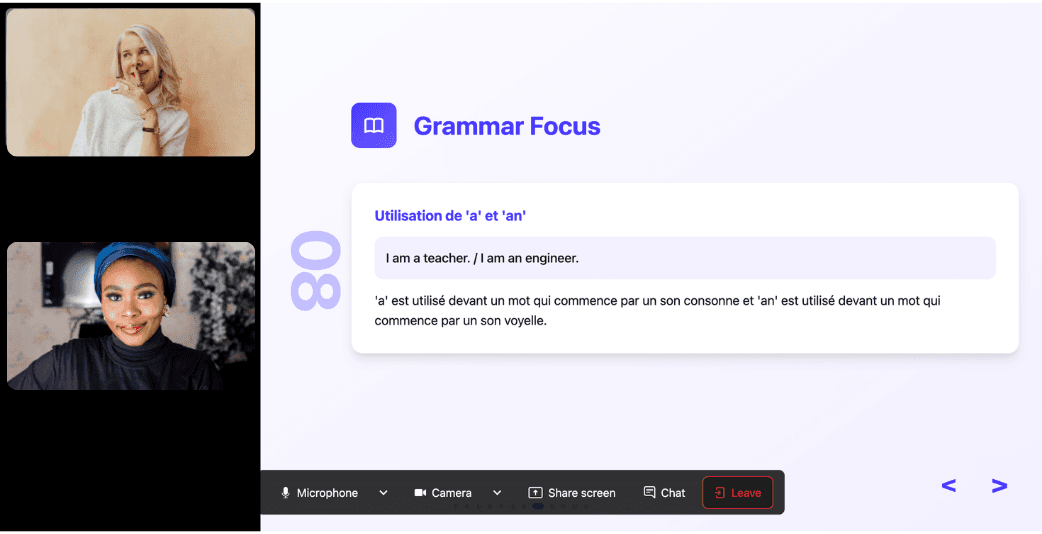
Ask all the questions you want, repeat sections if needed, and customize your learning experience in ways traditional teachers and generic apps simply can’t match.
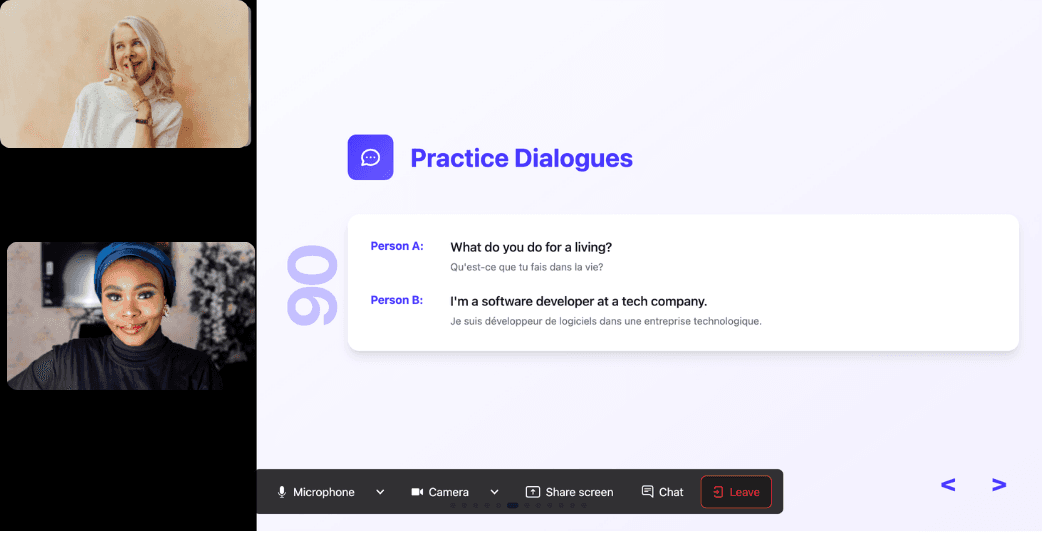
With 24/7 access at a fraction of the cost of private lessons, Kylian removes all the barriers that have kept you from mastering the language you’ve always wanted to learn.
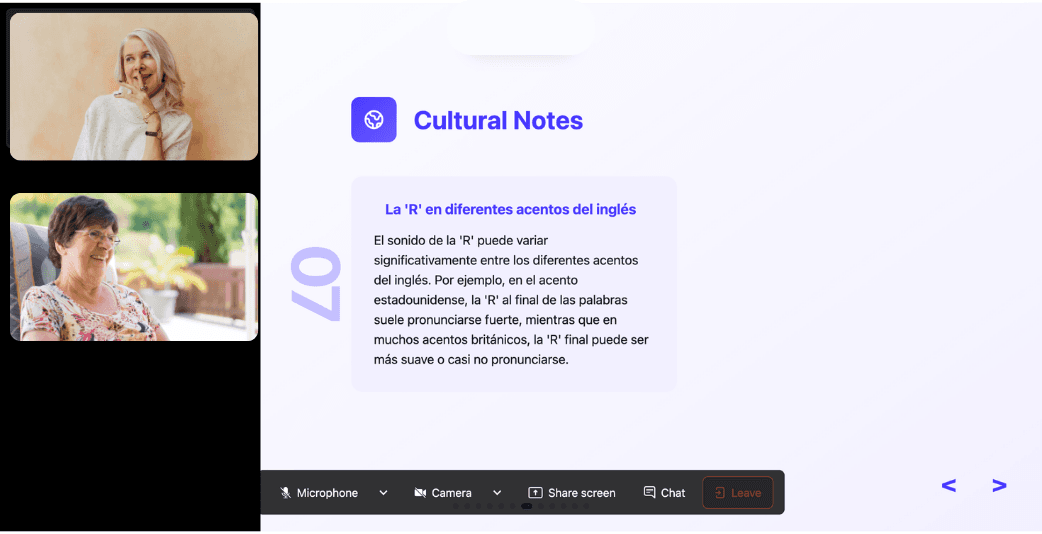
Similar Content You Might Want To Read

How to Write a Letter in Japanese: A Step-by-Step Guide
The persistence of formal letter writing in Japan reveals something profound about Japanese business culture and social structure. While the rest of the world has largely abandoned postal correspondence for digital alternatives, Japan maintains a robust tradition of written communication that extends far beyond nostalgia. This reality matters because Japan's bureaucratic systems, business protocols, and social expectations still demand fluency in formal letter writing. Understanding this communication method isn't merely academic—it's essential for anyone conducting serious business or establishing meaningful relationships in Japan. The stakes are higher than many realize. A poorly constructed Japanese letter doesn't just reflect poor language skills; it signals a fundamental misunderstanding of Japanese social hierarchy, respect protocols, and professional standards. Conversely, mastering this format demonstrates cultural competence and opens doors that remain closed to those who rely solely on modern communication methods.

Konnichiwa! Your Guide to Japanese Greetings & Farewells
Learning a few essential phrases in Japanese opens doors to meaningful connections when traveling to Japan or interacting with Japanese speakers. Beyond practical communication, mastering these expressions demonstrates respect for Japanese culture and social etiquette. This guide explores the fundamentals of Japanese greetings and farewells, equipping you with crucial phrases to navigate various social contexts with confidence.

Understanding "I'm Not Very Subtle" in English
Communication extends far beyond mere words—it's about nuance, inference, and the delicate art of subtlety. When someone says, "I'm not very subtle with things," they're acknowledging a critical aspect of their communication style that shapes how they navigate social interactions, convey ideas, and express themselves. This self-assessment reveals a preference for directness over indirectness, explicitness over implicitness, and sometimes bluntness over tact. Understanding subtlety—and its absence—offers profound insights into the mechanics of human communication. The concept transcends mere linguistic theory; it impacts relationships, professional success, cultural adaptation, and personal growth. By examining what it means to be subtle or not subtle, we unlock a deeper comprehension of effective communication strategies that can transform our interactions across various contexts.

What is the Abbreviation for Boulevard in English?
In the world of addresses and street naming conventions, abbreviations serve a critical purpose - they save space while maintaining clarity in written communication. Understanding these abbreviations is essential for anyone who needs to navigate urban environments or communicate location information effectively. This article examines one of the most common street type abbreviations: boulevard.

Road Abbreviations in English: The Guide
Road abbreviations serve as critical linguistic shortcuts that streamline communication, particularly in addresses, navigation systems, and traffic signs. Understanding these abbreviated forms isn't merely an academic exercise—it's a practical necessity for anyone navigating English-speaking territories, whether physically or through correspondence.

5 Business Letter Formats: Templates & Best Practices
Effective communication is the cornerstone of successful business relationships. While digital correspondence has largely replaced traditional methods, physical business letters remain uniquely powerful. They demonstrate commitment, convey formality, and signal importance in a way that digital alternatives simply cannot match. When a message demands gravitas, nothing compares to a properly formatted business letter. This deliberate approach to communication speaks volumes about your professionalism and the significance of your message before the recipient reads a single word.